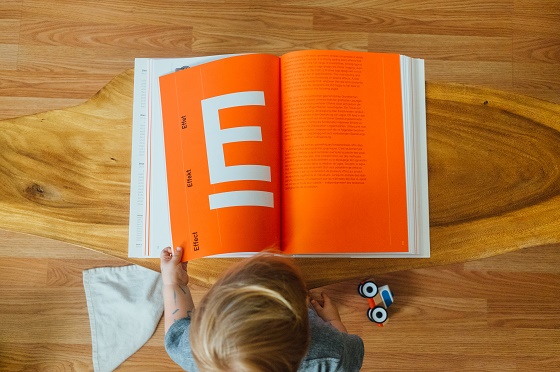What does the London Underground taste like? What would time look like if you drew it? In this post Elisabeth Reinisch explores different types of synaesthesia and considers the genetic and environmental factors that trigger it. Part of the PB101: Foundations of Psychological Science series (access the whole series here).

If I asked you what the London underground tastes like, would you have an answer? Maybe you would frown at me, and then go on to think of some pre-pandemic, tube commutes. Personally, I’ve experienced hot, crowed tube rides as a tourist, so you can only imagine what answer I might eventually come up with.
James Wannerton, however, would not need long to think of a response. He has a condition called phoneme – taste synaesthesia, where hearing speech, his own and that of others, causes him to taste specific flavours (Cytowic and Eagleman, 2011, p. 146). To him, LSE’s signature station, Holborn, for example, tastes like burned matches. Moreover, Covent Garden tastes like chocolate digestives, and Russell Square like celery.
The list goes on – check out his annotated map here.
Yet, words causing tastes is not the only atypical interaction of senses out there. Musical notes can lead to perceived clouds of colours, visual observations can result in a perception of touch, and numbers, weekdays, and even people can elicit colour associations or experiences (Ward, 2013, p. 54).
All of these processes fall under the condition of synaesthesia, Greek for “joined sensation” (Cytowic and Eagleman, 2011, p. 1). Synaesthesia is an involuntary, automatic experience caused by a stimulus (the sound of “Russell Square”) normally not producing such a result (taste of celery) (Ward, 2013, p. 50; Witthoft and Winawer, 2013, p. 258). There are over 60 different types of synaesthesia, with 1 in 23 individuals having at least one of them (Brang and Ramachadran, 2001; Cytowic and Eagleman, 2011, p. 8).
Even besides synaesthesia, our senses are not as segmented as we may think (Spence et al., 2003). Yes, we see with our eyes and hear with our ears – but they often work in unison. The McGurk effect, for instance, showed the importance of visual lip-reading in combination with auditory information. The notion that “eyes” can trick “ears” into misunderstanding seems to be true for individuals from Western societies, but not so much for Japanese individuals due to certain cultural communication differences (Sekiyama, 1997).
So, are synaesthetes and non-synaesthetes also distinguished based on cultural grounds?
Research suggests that synaesthesia is genetic, as it runs in families (Brang and Ramachandran, 2001). Yet, attributions seem to be unique for each individual (Ward, 2013), indicating a possible impact of nurture. If you have synaesthesia, you are likely to have a synaesthete family member, but rather unlikely to share the same colour-letter associations, for instance.
Synaesthesia might be caused by specific cross-wiring of the brain.
To understand that, it is important to appreciate that your brain is constantly re-wiring, as you learn new things and adapt to your environment (Petanjek et al., 2011). Learning to read, for example, changes the organisation of certain parts of your brain as new connections are formed (Dehaene et al., 2010). Furthermore, the ability to rewire is incredibly important in early development. The number of neurons and synapses present in early stages is far higher than the number retained into adulthood, with pruning eliminating the redundant connections (Kolb, 2013).
One hypothesis suggests that everyone is born a synaesthete, with cross-sensory brain connections. However, one assumes that, for most people, pruning gets rid of these networks. Yet, certain genetic predispositions cause a lack of pruning in some people and lead those to become synaesthetes (Ward, 2013).
But what are the evolutionary advantages that lead synaesthesia to survive? To understand that, let’s take a look at specific types of synaesthesia.
Curvy decades
How do you see time? For me, a year, for example, looks like a three-dimensional frisbee. Thinking about summer plans, I would view the months of July and August from the perspective of the current month. This is called sequence–location synaesthesia. Typically, most people would agree that numbers are arranged in a certain sequence. This can often have cultural origins, like whether you read from left to right or vice versa. However, synaesthetes might not only visualise sequences two-, but three-dimensionally. When picturing timelines, the number forms often curve at the decades and might be arranged in a way that indicates significance of certain time periods. (Cytowic and Eagleman, 2009).

This visualisation of time periods could be an evolutionary advantage for synaesthetes, as studies show that news, events and dates can be better remembered by them. Furthermore, there could be a link to savantism, as certain individuals were able to “use” their synaesthesia to remember the first 22.500 digits of pi (Brang and Ramachandran, 2001).
7 is Bright Orange
One of the most common forms of synaesthesia is colour-grapheme synaesthesia. Synaesthetes with this variant associate or experience colours when perceiving numbers or letters, with similarly shaped letters often eliciting similar shades. (Brang et al., 2011) Additionally, they seem to be better at distinguishing colours (Ward, 2013). However, this might not be due to their synaesthesia but rather due to further experience with colours. In fact, colour perception varies cross-culturally with certain cultures being better at distinguishing between shades of red, for example, due to more specific vocabulary (Thierry et al., 2009).
Why watching horror movies can be painful. Literally.
First, let me introduce you to mirror neurons. These are a type of brain cell facilitating social learning (Rizzolatti and Craighero, 2004). The same mirror neurons lighting up when I wave at someone, can light up when I perceive someone else waving (Shmuelof and Zohary, 2007). This is not only a valuable path to learn how to imitate others as a child but might also be linked to (but not necessarily cause) empathy (Lamm and Majdanzic, 2014).
However, this “empathy” can go rather far, with some people truly feeling what others are feeling. With mirror–touch synaesthesia, seeing someone else being touched on their cheek can make you feel a sensation of touch on your own cheek. Furthermore, some individuals even feel pain when seeing others in pain – possibly comparable to the sensation of feeling phantom pain after losing a limb (Ward and Banissy, 2015). Therefore, certain cases report a revulsion to watching horror movies or similar content (Cytowic and Eagleman, 2009).
Altogether, synaesthesia seems to be triggered by genes combined with environmental factors. It might be the cause for certain individual differences, like an ability to better distinguish colours, remember dates or be more responsive to seeing pain – possibly all reasons for synaesthesia to be passed on. Nevertheless, synaesthesia might also simply co-exist with these traits instead of causing them, therefore, letting the gene survive without harm.
Do you want to hear colour? Check this out.
Notes:
- This blog post was originally written as part of PB101: Foundations of Psychological Science, a compulsory course on the BSc Psychological and Behavioural Science programme in the Department of Psychological and Behavioural Science at LSE. It has been published with the permission of the author. Visit the PBS website for more information on studying in the department: https://www.lse.ac.uk/PBS/Study.
- The views expressed in this post are of the author and not the Department of Psychological and Behavioural Science or LSE.
- Featured banner image by Ryan Quintal on Unsplash
- Image of the London Underground by Max Patel on Unsplash.
- Image of year timeline created by the author.
Bibliography
Brang, D., & Ramachandran, V. S. (2001). Survival of the Synesthesia Gene: Why Do People Hear Colors and Taste Words? PLoS Biol, 9(11), e1001205. Retrieved from: https://doi.org/10.1016/j.neuropsychologia.2011.01.002
Brang, D., Rouw, R., Ramachandran, V. S., & Coulson, S. (2011). Similarly shaped letters evoke similar colors in grapheme–color synesthesia. Neuropsychologia, 49(5), 1355-1358. Retrieved from: https://doi.org/10.1016/j.neuropsychologia.2011.01.002
Cytowic, R. E., & Eagleman, D. M. (2009). wednesday is indigo blue: discovering the brain of synesthesia. MIT Press.
Dehaene, S., Pegado, F., Braga, L. W., & Ventura, P. (2010). How Learning to Read Changes the Cortical Networks for Vision and Language. Science, 300(6009), 1359-64. Retrieved from: https://doi.org/10.1126/science.1194140
Grossenbacher, P. G., & Lovelace, C. T. (2001). Mechanisms of synesthesia: cognitive and physiological constraints. Trends in Cognitive Science, 5(1), 36-41. Retrieved from: https://doi.org/10.1016/s1364-6613(00)01571-0.
Kolb, B., Mychasiuk, R., Muhammad, A., & Gibb, R. (2013). Chapter 2 – Brain Plasticity in the Developing Brain. Progress in Brain Research, 207, 35-64. Retrieved from: https://doi.org/10.1016/B978-0-444-63327-9.00005-9
Lamm, C., & Majdandzic, J. (2015). The role of shared neural activations, mirror neurons, and morality in empathy – A critical comment. Neuroscience Research, 90, 15-24. Retrieved from: https://doi.org/10.1016/j.neures.2014.10.008
Petanjek, Z., Judaš, M., Simic, G., Rasin, M. R., Uylings, H. B., Rakic, P., & Kostovic, I. (2011). Extraordinary neoteny of synaptic spines in the human prefrontal cortex. PNAS, 108(32), 13281-13286. Retrieved from: https://doi.org/10.1073/pnas.1105108108
Rizzolatti, G., & Craighero, L. (2004). THE MIRROR-NEURON SYSTEM. Annual Reviews of Neuroscience, 27, 169-192. Retrieved from: https://doi.org/10.1146/annurev.neuro.27.070203.144230
Sekiyama, K. (1997). Cultural and linguistic factors in audiovisual speech processing: The McGurk effect in Chinese subjects. Perception & Psychophysics, 59, 73-80. Retrieved from: https://doi.org/10.3758/BF03206849
Shmuelof, L., & Zohary, E. (2007). Watching others’ actions: mirror representations in the parietal cortex. Neuroscientist, 13(6), 667-72. Retrieved from: https://doi.org/10.1177/1073858407302457
Spence, C., & Squire, S. (2003). Multisensory Integration: Maintaining the Perception of Synchrony Author links open overlay panel. Current Biology, 13(13), R519-R521. Retrieved from: https://doi.org/10.1016/S0960-9822(03)00445-7
Thierry, G., & al., e. (2009). Unconscious effects of language-specific terminology on preattentive color perception. PNAS, 106(11), 4567-4570. Retrieved from: https://doi.org/10.1073/pnas.0811155106
Ward, J. (2013). Synesthesia. Annual Review of Psychology, 64, 49-75. Retrieved from: https://doi.org/10.1146/annurev-psych-113011-143840
Ward, J., & Banissy, M. J. (2015). Explaining mirror-touch synesthesia. Cognitive Neuroscience, 6(2-3), 118-133. Retrieved from: https://doi.org/10.1080/17588928.2015.1042444
Witthoft, N., & Winawer, J. (2013). Learning, Memory, and Synesthesia. Psychological Science, 24(3), 258-265. Retrieved from: https://doi.org/10.1177%2F0956797612452573





This was so interesting and such a great read. Perhaps this idea also explains associative memory— why we associate emotions and feelings so profoundly with things like music?
How interesting!
The study (https://ivypanda.com/essays/music-and-neuroscience/) of how music affects memory, motivation, and confidence has been the theme of interest for many researchers in this field. And such new discoveries like your article tends me to think about all the studies about music I have read. And of course about everything that I can`t know about music.